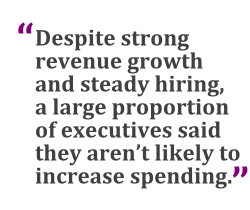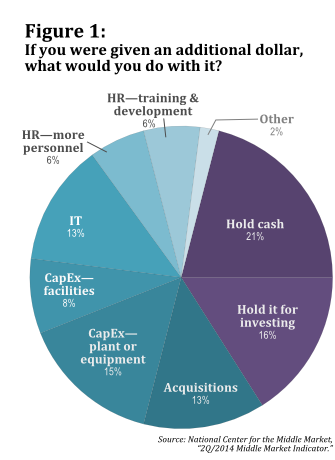 The economic recovery has been a long journey with regularsetbacks. But in a sign that the tide may have definitively turnedfor the U.S. economy, the latest National Center for the MiddleMarket (NCMM) Indicator survey found continued, strong revenuegeneration and economic optimism across broad segments of themiddle market.
The economic recovery has been a long journey with regularsetbacks. But in a sign that the tide may have definitively turnedfor the U.S. economy, the latest National Center for the MiddleMarket (NCMM) Indicator survey found continued, strong revenuegeneration and economic optimism across broad segments of themiddle market.
Businesses with annual revenue between $10 million and $1billion employ 41 million people and contribute about a third ofthe nation's gross domestic product. And they are recovering morequickly than other sectors of the economy, suggests a survey of1,000 C-suite executives from midmarket firms conducted by theNCMM, a research partnership of The Ohio State University FisherCollege of Business and GE Capital.
|For one thing, the survey indicates revenue is growing nearlytwice as fast in the middle market as among the S&P 500. Surveyrespondents reported year-over-year revenue increases of 6.6percent in the second quarter of 2014, which was on top of 6.5percent gains in the first quarter. Overall, 69 percent of surveyedcompanies reported an increase, while just 11 percent reported adecline in the second quarter. What's more, executives' outlooksare broadly positive: Seventy percent said they expect revenues toincrease over the next 12 months, by an average of 5.8 percent.That's a big jump from the first quarter, when 59 percent said theyexpected revenues to increase. And today, about a quarter ofexecutives expect revenue growth above 10 percent.
|Another telling result of the survey concerned employment. Inthe second quarter, 44 percent of respondents said employmentincreased over the past year, compared with 14 percent who reporteddeclines. For the middle market as a whole, employment rose 3.2percent; the group expects employment to grow another 3.3 percentover the next 12 months. Also, there is growing concern amongrespondents about finding and retaining talent, a good indicatorthat employment and wages may rise further.
|At the macro level, executives also expressed optimism. Whenasked to rank their confidence in the U.S. economy, more thantwo-thirds of respondents—68 percent—reported being at leastsomewhat confident. This suggests that growth will continue. Infact, the survey suggests 62 percent of midmarket executivesbelieve the U.S. economy will grow over the next 12 months, asignificant 12 percentage point uptick over the first quarter. Andonly 9 percent believe the economy will contract. On average,survey respondents expect the U.S. economy to grow by 1.7 percentover the next 12 months, which is the highest rate predicted in anyof the past four quarters.
|Four industry sectors are particularly optimistic about theirprospects over the next 12 months and expect revenue growth abovethe national average: construction (8.1 percent growth), services(8 percent growth), manufacturing (7.2 growth), and financialservices (6.7 growth). Construction firms are also optimistic aboutemployment; they plan to hire new employees so quickly that theirworkforce will grow by 5.1 percent over the next 12 months.
|Challenges Remain
| Despite these positive signs, the survey indicated somechallenges for midmarket businesses. Health care costs remain a topconcern for respondents. The number of midmarket executives citingthe cost of health care as “highly challenging” bounced back to 54percent in Q2/2014 after dipping to 46 percent in the firstquarter.
Despite these positive signs, the survey indicated somechallenges for midmarket businesses. Health care costs remain a topconcern for respondents. The number of midmarket executives citingthe cost of health care as “highly challenging” bounced back to 54percent in Q2/2014 after dipping to 46 percent in the firstquarter.
In addition, executives are increasingly concerned aboutgovernment actions. Half said that the regulatory environment ismore restrictive than it was a year ago. Another major concern isuncertainty about tax policies; 20 percent said corporate taxplanning is highly challenging. That's up from 13 percent in thelast quarter, which suggests that executives have a dim view oflawmakers' ability to compromise on tax reform.
||Two other challenges that CFOs always pay close attentionto—access to capital and borrowing costs—are becoming easier formidmarket businesses. In the second quarter, 42 percent ofrespondents described access to capital or financing as highly orsomewhat challenging, down from 51 percent in the first quarter.Similarly, 37 percent said borrowing costs were highly or somewhatchallenging, down from 47 percent in the first quarter.
||
Investment Remains Flat
|One way the survey gauges the mind-set of executives is byasking what they would do if given an additional dollar. The latestreport shows that 37 percent would keep the extra cash on handrather than investing it in their business right away—althoughclose to half of those said they would hold the cash for futureinvestment (see Figure 1). Thirty-seven percent is a rather highproportion to hold onto the cash, but that number has beenconsistent over the past several quarters, going back to 2012.
| The take-away is that despite strong revenue growth andsteady hiring, and expectations that we will continue to see moreof the same, a large proportion of executives said they aren'tlikely to increase spending. In comparison with the first quarterof 2014, a lower proportion of middle-market executives said in Q2that they would spend additional earnings on training anddevelopment, or on capital expenditures (plant, equipment, orfacilities).
The take-away is that despite strong revenue growth andsteady hiring, and expectations that we will continue to see moreof the same, a large proportion of executives said they aren'tlikely to increase spending. In comparison with the first quarterof 2014, a lower proportion of middle-market executives said in Q2that they would spend additional earnings on training anddevelopment, or on capital expenditures (plant, equipment, orfacilities).
When considered in combination, this survey's findings are veryinteresting. Many executives expect their business to continue togrow, but since they're not planning to increase spending, theymust believe they can lock in that growth through productivitygains alone. As every treasurer knows, sustainable growth requiresfinding the right balance between maintaining cash reserves andmaking smart investments in the future of the business.
|The reluctance to make major outlays in today's economic climateis understandable. Not only are they looking at a fitful economicrecovery, but midsize companies tend to be conservatively run,family-owned businesses in the habit of guarding every dollar andeschewing risk. Nevertheless, treasurers and other finance managerswho intend to keep growing should ask themselves whether theirexpectations around capital investments are realistic to continueto capture growth, or whether they should be planning to investmore in people and equipment.
|—————————————-
| Bob McCarrick is chief commercialofficer, lending at GE Capital, CorporateFinance, which specializes in providing commercial loansand equipment finance to midsize companies for growth,acquisitions, turnarounds, and balance sheet optimization.
Bob McCarrick is chief commercialofficer, lending at GE Capital, CorporateFinance, which specializes in providing commercial loansand equipment finance to midsize companies for growth,acquisitions, turnarounds, and balance sheet optimization.
Complete your profile to continue reading and get FREE access to Treasury & Risk, part of your ALM digital membership.
Your access to unlimited Treasury & Risk content isn’t changing.
Once you are an ALM digital member, you’ll receive:
- Critical Treasury & Risk information including in-depth analysis of treasury and finance best practices, case studies with corporate innovators, informative newsletters, educational webcasts and videos, and resources from industry leaders.
- Exclusive discounts on ALM and Treasury & Risk events.
- Access to other award-winning ALM websites including PropertyCasualty360.com and Law.com.
*May exclude premium content
Already have an account? Sign In
© 2024 ALM Global, LLC, All Rights Reserved. Request academic re-use from www.copyright.com. All other uses, submit a request to [email protected]. For more information visit Asset & Logo Licensing.







